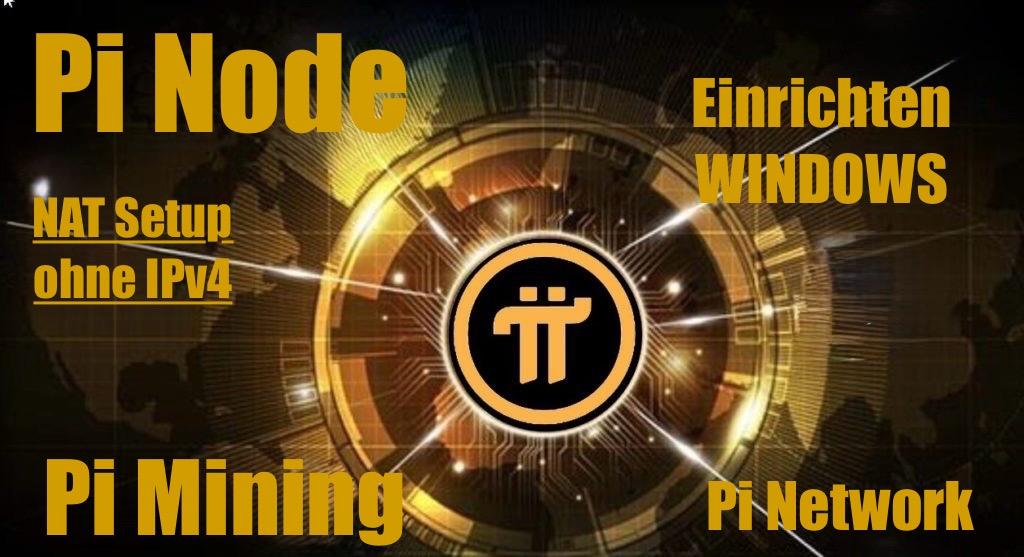Pi Node WINDOWS Installation | Without IPv4 Address / NAT
With the Pi Node WINDOWS installation, you get your own node and can even mine Pi Coins. This also secures your node rewards.
This article is specifically aimed at NAT Internet customers who cannot use an IPv4 address. We circumvent the problem with Cloudflare.
Support the crypto network and benefit in the future from what you are building today. The Pi Coin network is one of the most promising opportunities!
… the last ones get bitten by the dogs 😁
What is the Pi Network?
Pi Network is a blockchain project that aims to create a user-friendly, energy-efficient cryptocurrency that can be mined using smartphones – without the need for expensive hardware or high power consumption. Unlike Bitcoin, Pi relies on the Stellar Consensus Protocol (SCP), a mechanism based on a trust network. Users confirm each other in small groups, known as “security circles,” which decentralizes security while remaining energy-efficient.
Pi was founded in 2019 by a team led by Dr. Nicolas Kokkalis and Dr. Chengdiao Fan, both graduates of Stanford University. Since its launch, the community has grown to over 40 million users worldwide. The project started with a mobile app that allows users to earn Pi daily by simply clicking a button. Later, KYC verification, a dedicated wallet, decentralized apps (dApps), and the ability to operate a node (super node) to actively participate in the network were added.
The goal of the network is to establish a real everyday currency – for example, for online shops, services, or peer-to-peer payments. Pi Coin is not yet officially tradable, as the project is currently in a transition phase between the closed and open mainnet.
Follow the entire article. The Pi Node and the Pi Mini are connected to each other – you need both. The Node runs on the PC, the Pi Mini on the mobile phone. This is how you connect the Node to your mining account. This is also necessary to credit the rewards to your mining account and to verify the operator of the Node via KYC.
Video: Pi Node WINDOWS Installation | Without IPv4 Address / NAT
Language: 🇩🇪
☝️ Use YouTube subtitles for all languages.
Pi Coin Mining
In the Pi Network, “mining” does not refer to the classic mining with computing power, as is known from Bitcoin. Instead, it is a simple and energy-efficient process in which users can earn Pi Coins through their daily activity in the Pi app. To start a mining cycle, open the app once a day and tap the “lightning bolt” button. This starts a 24-hour cycle during which Pi Coins are automatically credited – without the smartphone having to actively work or consume a lot of battery power.
The mining rate depends on several factors: the current base rate, the number of trusted contacts in the so-called security circle, and whether you have invited other active users. As the network size increases, the base rate gradually decreases. Operating a node may also influence the reward in the future, but this is separate from mobile mining.
It is important to note that you have to be active every day to continue mining – it does not happen automatically. The coins earned are not yet freely tradable, as the network is still in the transition phase before the open mainnet. Once the mainnet is public, Pi Coins should be usable both within and outside the ecosystem.
Overall, Pi mining is designed so that anyone with a smartphone can participate – without technical knowledge or special hardware. It focuses on social interaction, trust, and ease of use rather than energy consumption.
Pi Mining Software and Invitation Code
To mine Pi, all you need is the Pi Network app, which you can download for free from the App Store or Google Play. After installing it, you must register and enter an invitation code—this is mandatory because Pi is based on a trust-based network. After registering, you can start mining right away: simply open the app and tap the lightning bolt button (⚡). This starts a 24-hour mining cycle during which Pi coins are automatically credited to your account. It is important to tap the button again every day, as mining does not continue automatically.
Just start with this link https://minepi.com/MikeKlis on your mobile phone or install the app manually on your mobile phone and use the invitation code MikeKlis.
You will then automatically be part of my security circle and can start building your own security circle.
After three days of mining, you can start building your security circle by adding trusted individuals who are also actively mining Pi. This will increase your mining speed. In addition, you can increase your rate by inviting new active users to the network or confirming your account via KYC verification. The mining process consumes very little battery power or data volume, as no actual computing work is running in the background – it is more a form of participation and confirmation of your activity on the network.
What is a node?
A node is a computer that is part of a blockchain network.
It helps keep the blockchain running by:
- Receives and forwards data
- Stores and verifies transactions
- Communicates with other nodes
You do not automatically receive Pi Coins for operating a node, and mining also runs separately via the mobile app. However, according to Pi Network, rewards are distributed to node operators – you can currently view these at https://minepi.com.
Supernode
A supernode in the Pi Network is a special type of node that actively participates in the blockchain consensus process. While normal nodes primarily help to support the network and forward transactions, supernodes perform the important task of validating transactions and confirming new blocks. To do this, they must meet certain technical requirements, such as a stable internet connection, sufficient computing power, and regular availability. Supernodes are selected by the Pi Core Team and are considered particularly trustworthy and powerful. They play a central role in the decentralization and security of the Pi Network.
Requirements for the node
This article is intended for users with NAT-based Internet access, as is often the case with DS-Lite, mobile connections, or behind routers without a public IPv4 address. In such cases, no directly accessible public IPv4 address is available, which normally prevents the operation of a Pi node—because it needs such an address to communicate with other nodes in the network. However, this problem can be circumvented with the help of Cloudflare: Cloudflare can act as an intermediary, enabling access to the node even without a publicly accessible IPv4 address.
WINDOWS 10 Home, Pro, or higher
WINDOWS 11
WSL and Docker desktop (no VMs (virtual machines) are supported!)
An internet domain (such as “www.meineSeite.de”)
A free account with Cloudflare
Update your system (WINDOWS update) and the above programs.
Possible problems
If Docker Toolbox or VirtualBox is already installed on your computer, this may cause problems.
In this case, uninstall Docker Toolbox. If that doesn’t work, uninstall VirtualBox as well – although I haven’t had any problems with VirtualBox so far.
Set up Cloudflare Tunnel
Log in to Cloudflare, select “Zero Trust” → “Network” → “Tunnel.”
Now you need to configure ports 31400 to 31409 in the tunnel. Please follow the video, which explains this in detail.
Also, pay attention to whether your tunnel is online or offline.
You can find detailed instructions on setting up Cloudflare tunnels in this article:
Configuring Windows Firewall
Please refer to the video for this section as well. It shows you how to do it – much easier than explaining it here in text form.
The docker-compose.yml
Now add a new tunnel and make a note of the tunnel token, or copy it for the docker-compose.yml file.
Install the tunnel software on your system. To do this, use the docker-compose.yml that I provide here:
# version: '3'
services:
tunnel:
image: cloudflare/cloudflared:latest
container_name: cloudflared-tunnel
command: 'tunnel run --token DeinTunnelToken'
restart: unless-stopped
networks:
- internalcore
networks:
internalcore:
driver: bridgeYou must enter your token under “Your Tunnel Token,” otherwise Cloudflare will not be able to assign your tunnel.
Save the “docker-compose.yml” file in the directory where you want to store the Docker data. For example, I use D:/Docker SERVER/internalcore, but you can choose any directory you like.
Start Docker in a command prompt in the directory you have chosen with:
docker-compose up -dThe container data is now being pulled; this will not take long.
“Internalcore” now appears in Docker Desktop, with the “Cloudflare Tunnel” container below it.
Installing PI Node
To run a Pi Node on your computer, you must first download the official Pi Node software from the website https://node.minepi.com. The software is available for Windows, macOS, and Linux. After downloading, install the program like a normal desktop application.
Once the installation is complete, start the Pi Node and log in with your existing Pi Network account. This works as follows:
The node software will ask you to enter a verification code.
You will receive this code when you launch the mobile app (which you use for mining). Go to the “hamburger menu” in the top right corner and select “Node.” Then enter the code in the node software and confirm it. Finally, confirm the process on your mobile phone.
In the next step, the software automatically checks whether your system meets the necessary requirements. It is important that Docker Desktop is installed and functional, as the Node software is based on Docker containers in the background. If you do not have Docker installed yet, please do so as described above in this article. It is a prerequisite – you cannot proceed without it.
Once you have checked the node as described in the video, start it with the switch as shown.
The Pi node automatically starts a container in the background and connects to the network. In the node’s user interface, you can now view the status of your connection, ports, synchronization, and log data. From this point on, your node is active and you support the network by forwarding transactions and contributing to the structure of the decentralized infrastructure.
Note: Synchronizing the node can take up to an hour.
If you are technically savvy and your system runs stably, you can also apply to become a supernode candidate within the node software. Supernodes play an important role in the network’s consensus process and are subject to stricter requirements—for example, in terms of accessibility, performance, and network stability.
The Pi Node generally requires little maintenance. The only important thing is that your computer is regularly online, Docker is running correctly, and you occasionally check for updates.

Support / Donation Link for the Channel
If my posts have been helpful or supported you in any way, I’d truly appreciate your support 🙏
#PiNode #PiCoin #PiSuperNode #PiNetwork #Crypto #Docker #PiMining #PassiveIncome #Blockchain #Web3



